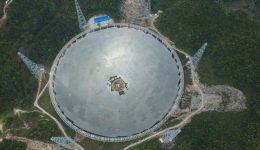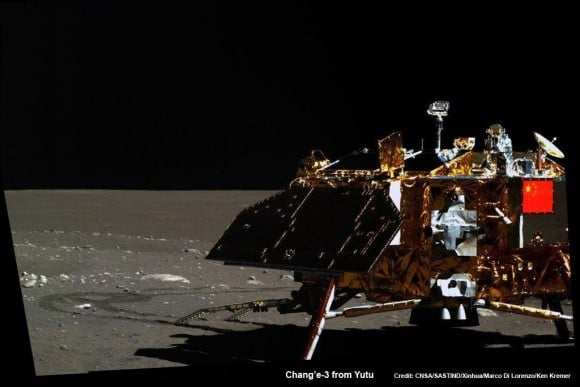Relax, its not a space station! And according to the Chinese government, it's for entirely peaceful purposes. It's known as the
Five-hundred-meter Aperture Spherical Telescope (FAST), a massive array t
hat just finished construction
in the
southerwestern province of Guizhou, China. Equivalent in size to over 20 football fields joined end to end, it is the world's largest radio telescope - thus ending the Arecibo Observatory's 53 year reign.
As part of China's growing commitment to space exploration, the FAST telescope will spend the coming decades exploring space and assisting in the hunt for extraterrestrial life. And once it commences operations this coming September, the Chinese expect it will remain the global leader in radio astronomy for the next ten or twenty years.
In addition to being larger than the Arecibo Observatory (which measures 305 meters in diameter), the telescope is reportedly
10 times more sensitive than its closest competitor - the steerable 100-meter telescope near Bonn, Germany. What's more, unlike Arecibo (which has a fixed spherical curvature), FAST is capable of forming a parabolic mirror. That will allow researchers a greater degree of flexibility.
The Chinese Academy of Sciences (CAS) has spent the past five years building the telesccope, to the tune of
1.2-billion-yuan (180 million U.S. dollars). As the deputy head of the
National Astronomical Observation, which is overseen by the CAS, Zheng Xiaonian was present at the celebrations marking the completion of the massive telescope.
As he was paraphrased as saying by the
- Xinhua News Agency
-
"The project has the potential to search for more strange objects to better understand the origin of the universe and boost the global hunt for extraterrestrial life." Zheng was also quoted as saying that he expects FAST to
be the global leader in radio astronomy for the next 10 to 20 years.
The construction of this array has also been a source of controversy. To protect the telescope from radio interference, Chinese authorities built FAST in Guizhou province's isolated Dawodang depression, directly into the mountainside. However, to ensure that no magnetic disruptions are nearby, roughly 9,000 people are being removed from their homes and rehoused in the neighboring counties of
Pingtang and Luodian.
Li Yuecheng is the secretary-general of the
Guizhou Provincial Committee, which is part of the
Chinese People's Political Consultative Conference (CPPCC)
.
As he was quoted as saying by the Xinhua News Agency, the move comes with compensation:
[caption id="attachment_110385" align="aligncenter" width="580"]
China's recent forays into space include the Chang'e-3 moon lander, seen here by the Yutu moon rover. Credit: CNSA/SASTIND/Xinhua/Marco Di Lorenzo/Ken Kremer
[/caption]
In addition, the construction of this telescope is seen by some as part of a growing desire on behalf of China to press its interests in the geopolitical realm. For instance, in their
2016 Annual Report
to Congress, the Department of Defense indicated that China is looking to develop its space capabilities to prevent adversaries from being able to use space-based assets in a crisis. As the report states:
However, for others, FAST is merely the latest step in China's effort to become a superpower in the all-important domain of space exploration and research. Their other ambitions include mounting
a crewed mission to the Moon by 2036 and building a space station (for which work has already begun). In addition, FAST will enable China to take part in another major area of space research, which is the search for extra-terrestrial life.
For decades, countries like the United States have leading this search through efforts like the
SETI Institute
and the
Nexus for Exoplanet System Science
(NExSS). But with the completion of this array, China now has the opportunity to make significant contributions in the hunt for alien intelligence.
In the meantime, the CAS' scientists will be debugging the telescope and conducting trials in preparation for its activation, come September. Once it is operational, it will assist in other areas of research as well, which will include conducting surveys of neutral hydrogen in the Milky Way and other galaxies, as well as detecting pulsars and gravitational waves.
Further Reading:
Xinhuanet
 Universe Today
Universe Today


